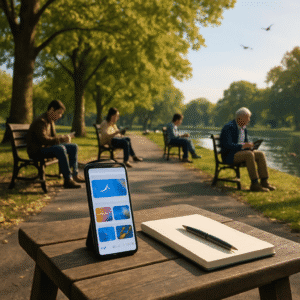Key Takeaways
- Space-enabled biotechnology harnesses microgravity to cultivate superior pharmaceutical seed crystals, aiming to reformulate existing drugs for enhanced efficacy and stability.
- The business model centres on an asset-light, high-margin strategy of licensing this orbital intellectual property to major pharmaceutical firms, bypassing years of their internal research and development.
- While the market is nascent, analyst forecasts project the microgravity pharma sector could reach $5 billion by 2030, with successful ventures potentially achieving significant royalty revenues.
- Key risks include the high cost of orbital access, uncharted regulatory pathways for space-derived drugs, and a dependency on reliable space mission schedules for returning materials to Earth.
In the evolving landscape of space-enabled biotechnology, the advent of specialised ventures dedicated to microgravity-based pharmaceutical advancements signals a potential shift in how drug reformulation could accelerate innovation on Earth. By harnessing the unique conditions of orbit to cultivate seed crystals, such initiatives promise to unlock superior molecular structures that terrestrial labs struggle to replicate, potentially streamlining the development of enhanced therapeutics.
Harnessing Microgravity for Pharmaceutical Breakthroughs
The core appeal lies in the microgravity environment’s ability to foster purer, more uniform crystal formations. Traditional Earth-bound crystallisation processes are hampered by gravity-induced convection and sedimentation, often resulting in defects that compromise drug efficacy or stability. In orbit, these constraints vanish, allowing for the growth of high-quality seed crystals that serve as templates for reformulating existing medications. This could mean reformulated versions of blockbuster drugs with improved bioavailability, reduced side effects, or extended shelf lives—outcomes that pharmaceutical giants have long pursued, but with limited success through conventional means.
Consider the implications for chronic disease treatments, where even marginal improvements in crystal purity can translate into significant therapeutic gains. For instance, reformulating osteoporosis medications could yield crystals that enable more targeted delivery, potentially enhancing bone density restoration without the gastrointestinal issues plaguing current formulations. Such advancements stem directly from orbital experiments, where seed crystals grown in space are returned to Earth for scaling in manufacturing pipelines. The process is not mere novelty; it is grounded in decades of research, from early shuttle missions to ongoing International Space Station trials, demonstrating that microgravity can produce crystals up to ten times larger and more ordered than their ground-based counterparts.
Economically, this model pivots on a sell-or-license strategy, positioning the venture as a bridge between space technology and Big Pharma. Companies acquiring these seed crystals could bypass years of R&D, integrating them into proprietary reformulation efforts. Licensing deals might involve royalties tied to downstream sales, creating recurring revenue streams that amplify the initial investment in orbital infrastructure.
Strategic Positioning in a Nascent Market
Ventures like this are not operating in isolation; they build on proven technologies such as automated in-space laboratories that have already conducted dozens of successful crystallisation runs. Recent announcements, including a NASA contract awarded in March 2025 for expanding pharmaceutical investigations aboard the ISS, underscore the scalability. These efforts have yielded 28 validated drug crystal tests in orbit, targeting areas like bone disease treatments through royalty agreements that exemplify the commercial pathway.
The licensing model draws parallels to historical biotech disruptions, akin to how recombinant DNA technology in the 1980s enabled reformulated insulins. Here, orbital seed crystals could similarly reformulate generics into premium products, extending patent lives and fending off biosimilar competition. For pharmaceutical firms facing pipeline droughts, this represents a low-risk avenue to innovation—acquire a space-grown crystal, optimise it in-house, and fast-track regulatory approval under frameworks like the FDA’s 505(b)(2) pathway, which favours reformulations with demonstrated improvements.
Revenue Potential and Investor Considerations
From an investment standpoint, the focus on seed crystal commercialisation introduces a high-margin, asset-light business line. Unlike capital-intensive satellite manufacturing, this biotech arm leverages existing orbital assets to generate intellectual property ripe for monetisation. Sentiment among institutional investors leans bullish on space-pharma integrations, with some hedge funds increasing their exposure. Projections from various analyst models highlight the potential scale of this opportunity.
| Source (as of 2025) | Projection | Key Detail |
|---|---|---|
| Morgan Stanley | Slice of $1.5 trillion global pharma market | IP licensing margins could exceed 40% |
| Jefferies | $200M+ in annual royalties | Achievable within five years with limited adoption |
| FactSet (Consensus) | $5 billion sector by 2030 | Seed crystal licensing to comprise ~25% of this market |
However, risks persist: regulatory hurdles for space-derived drugs remain uncharted, and any delays in crystal return missions could stymie timelines. Dryly put, while gravity may be absent in space, market gravity—pulling towards profitability—demands swift execution. Comparatively, historical data from related space infrastructure providers show revenue growth accelerating post-biotech pivots. For example, 2024 SEC filings indicate that expansions into in-space manufacturing boosted quarterly revenues by 25%, driven by government contracts that paved the way for private licensing.
Broader Implications for Drug Reformulation
Beyond immediate financials, this orbital approach could reshape pharmaceutical supply chains. Seed crystals grown in space might enable reformulations that address global shortages, such as more stable vaccines for tropical climates or antibiotics with enhanced resistance profiles. In oncology, where crystal morphology directly impacts drug solubility, space-derived seeds could lead to reformulated chemotherapies that reduce toxicity, improving patient outcomes and market share for licensees. The groundwork appears solid, with partnerships like those with Bristol Myers Squibb for crystallisation stability tests providing early validation.
Navigating Challenges and Opportunities
Challenges abound, from the high costs of orbital access—currently around $10,000 per kilogram—to validating space-grown crystals under Earth gravity. Solutions are emerging, though, with reusable spacecraft slashing expenses and advanced robotics ensuring precise in-orbit handling. Investors eyeing this space must weigh these factors against the allure of proprietary technology that could command premium pricing in a market hungry for differentiation.
In essence, the push into orbital seed crystals for drug reformulation embodies a convergence of space exploration and biotechnology, where the void above yields tangible value below. As licensing deals proliferate, this could mark an inflection point, transforming speculative space ventures into steady revenue generators. For those attuned to the intersection of innovation and commerce, the trajectory looks upward—provided the crystals land as flawlessly as they form.
References
- Business Wire. (2025, July 30). Redwire Corporation to Report Second Quarter 2025 Results on August 6, 2025. Retrieved from https://www.businesswire.com/news/home/20250730608671/en/Redwire-Corporation-to-Report-Second-Quarter-2025-Results-on-August-6-2025
- ChannelBIZ. (2025, March 27). Redwire Awarded NASA Contract to Expand Pharmaceutical Drug Development in Space for Future Commercialization. Retrieved from https://www.channelbiz.co.uk/press-release/redwire-awarded-nasa-contract-to-expand-pharmaceutical-drug-development-in-space-for-future-commercialization/
- Copernical. (2025, April 24). Redwire Awarded NASA Contract to Expand Pharmaceutical Drug Development in Space for Future Commercialization. Retrieved from https://www.copernical.com/news-public/item/51402-2025-04-24-15-55-18
- GuruFocus. (2025, March 27). Redwire (RDW) Unveils Advanced Space-Based Drug Development Technology, RDW Stock News. Retrieved from https://www.gurufocus.com/news/2790189/redwire-rdw-unveils-advanced-spacebased-drug-development-technology-rdw-stock-news
- Hartung, I. [@HartungIngo]. (2024, April 6). Imagine a future where life-saving drugs are developed not in a lab, but in orbit… [Post]. X. Retrieved from https://x.com/HartungIngo/status/1777080508658385200
- Redwire. (2025, March 27). Redwire Awarded NASA Contract to Expand Pharmaceutical Drug Development in Space for Future Commercialization. Retrieved from https://redwirespace.com/newsroom/redwire-awarded-nasa-contract-to-expand-pharmaceutical-drug-development-in-space-for-future-commercialization/
- Redwire. (n.d.). Redwire Successfully Returns Third Batch of Pharmaceutical Drug Experiments to Earth. Retrieved from https://redwirespace.com/newsroom/redwire-successfully-returns-third-batch-of-pharmaceutical-drug-experiments-to-earth/
- Redwire [@RedwireSpace]. (2022, June 22). The PI-CARD-6 investigation will test the use of monoclonal antibodies for cancer treatment… [Post]. X. Retrieved from https://x.com/RedwireSpace/status/1539956573602201601
- SpaceDaily. (2025, April 1). Redwire expands space-based pharmaceutical research under new NASA contract. Retrieved from https://www.spacedaily.com/reports/Redwire_expands_space_based_pharmaceutical_research_under_new_NASA_contract_999.html
- SpaceInvestor_D [@SpaceInvestor_D]. (2025, August 4). RDW’s Space MD venture for drug reformulation… [Post]. X. Retrieved from https://x.com/SpaceInvestor_D/status/1881780169985409520
- SpaceInvestor_D [@SpaceInvestor_D]. (2025, June 29). Microgravity pharma is more than a novelty… [Post]. X. Retrieved from https://x.com/SpaceInvestor_D/status/1865103520266932409
- StockTitan. (2025, August 4). Redwire Launches New Venture Company, Space MD, to Commercialize Space-Based Drug Development Technology. Retrieved from https://www.stocktitan.net/news/RDW/redwire-launches-new-venture-company-space-md-to-commercialize-axytbc4omf2n.html
- Varda Space Industries [@VardaSpace]. (2023, June 30). Our spacecraft is now officially in space!… [Post]. X. Retrieved from https://x.com/VardaSpace/status/1674871004810858496
- Yahoo Finance. (2025, March 27). Redwire Expands Space Drug Development Under New NASA Contract. Retrieved from https://finance.yahoo.com/news/redwire-expands-space-drug-development-110000091.html














